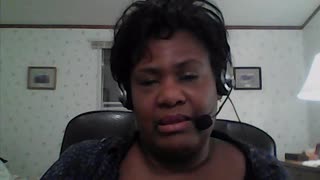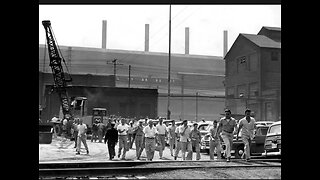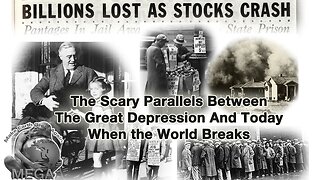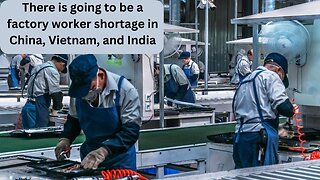Working Class #8-2023: How Many Economic Crashes? Having to Move to Find Work
Difference Between Small Business Owners vs Billionaire Business Owners: Small business owners are Workers have gone into business. Many times, small business owners do the work of their workers. Small business owners have the same amount of political power as most of the Working Class - NONE
To Work is To Live Under Capital: We have to buy the basics to survive: shelter, food and protection of the system. Every time the economy crashes, our lives are threatened.
What Triggers a Formal Declared an Economic Crash? Economic collapses are called by the government and social institutions (like media) ONLY IF the wealthiest are negatively affected by economic conditions. This means billionaires start hemorrhaging money.
Who Pays for Economic Crashes? The Working Class always is forced to pay, through loss of income, small businesses failures, our savings wiped out, foreclosures on homes, less services, declining quality of services, less protection from predatory capital, - this is always a transfer of what we have into the pockets of the wealthiest people and corporations in the U.S.
SOURCE: WIKIPEDIA "LIST OF RECESSIONS IN THE UNITED STATES": The listed dates and durations are from the official chronology of the National Bureau of Economic Research.
GDP data are from the Bureau of Economic Analysis, unemployment from the Bureau of Labor Statistics. The unemployment rate often reaches a peak associated with a recession after the recession has officially ended.
__________
PHOTO: PHOTO: I BELIEVE THIS WOMAN IS WORKING ON A LIBERTY SHIP DURING WWII
The Bethlehem-Fairfield Shipyard of Baltimore, Maryland, was a shipyard in the United States from 1941 until 1945. Located on the south shore of the Middle Branch of the Patapsco River which serves as the Baltimore Harbor, it was owned by the Bethlehem Shipbuilding Company, created by the Bethlehem Steel Corporation of Bethlehem, Pennsylvania, which had operated a major waterfront steel mill outside Baltimore to the southeast at Sparrows Point, Maryland in rural Baltimore County since the 1880s.
Fairfield Shipyard - WWII
The first two new shipyards established by the U.S. Maritime Commission in 1941 were the Oregon Shipbuilding Corporation in Portland, Oregon, and Bethlehem-Fairfield Shipyard, Incorporated in Baltimore, Maryland. To boost output, Bethlehem got a contract in February 1941 to build a shipyard at Fairfield, across Baltimore Harbor from Sparrows Point. The Fairfield Yard had the most employees of any Bethlehem shipyard - 44,625 in 1943 - and one of the finest construction records of the war.
The giant Bethlehem-Fairfield yard was built on the Baltimore Harbor, in the vicinity Bethlehem's existing naval yard and steel mill at Sparrow's Point. Such an old harbor did not have sufficient space on the waterfront to build both shipways and fabrication areas, so Bethlehem built its thirteen ways next to the water but located its fabricating plant about two miles away. At the fabricating plant, workers cut steel and assembled components by welding, making identical sections of up to ten tons each for ten ships at a time. Crane operators and riggers then moved those sections to outside work areas to be further welded into units of up to 25 tons. A system of cranes, locomotives, railroad cars, and locomotive cranes then transported the pre-assembled units the two miles to the yard, which was laid-out in order to efficiently receive and store the pre-assembled units before cranes moved them into position on the ways for erection of the hulls.
The first Liberty, the SS Patrick Henry, was built at Fairfield in 1941 and was ready for service in 244 days. The Maritime Commission declared 27 September 1941 as "Liberty Fleet Day" to celebrate the launching of the first ships in the new fleet. With President Roosevelt in attendance that day, Bethlehem-Fairfield at Baltimore launched the first one, the Patrick Henry. The publicity the celebration garnered led the "ugly ducklings" to claim a more noble name: Liberty ships.
Its workers would build 384 Liberty ships, ungainly but easily mass-produced cargo vessels. They were essentially a World War I design that didn't get into production then, but the government kept the plans ready. One Liberty could carry 2,840 jeeps, 440 tanks, or 230 million rounds of rifle ammunition.
SOURCE: https://www.globalsecurity.org/military/facility/fairfield.htm
___________
PLEASE LIKE AND SHARE THIS VIDEO! PLEASE FOLLOW THIS WORKING CLASS CHANNEL – ON YOUTUBE AND RUMBLE!
____________
DONATE INFO!
HELP WITH STORAGE UNIT EMERGENCY
- Go Fund Me at: https://www.gofundme.com/f/help-save-my-household-in-storage-from-auction
TO HELP KEEP CHANNEL GOING PLEASE - IF YOU CAN
- Buy Me a Coffee at: www.buymeacoffee.com/karenlouisv
DONATE TO HELP WEST BALTIMORE PHARMACUETICAL MANUFACTURING COOPERATIVE - FUNDING NEEDED FOR A ONE YEAR JOB TO OBTAIN MAJOR FUNDS AND BUILD COMMUNITY, CITY, STATEWIDE AND REGIONAL SUPPORT
- Indiegogo at: https://igg.me/at/wbpmc
Any amount, from a $1 or more, will help!
FOLLOW ME AT SUBSTACK: https://karenwilson.substack.com/
-
 1:00:50
1:00:50
Working Class
1 year agoWORKING CLASS #1-2023: What is Working Class? Growing Up In and Being Working Class
19 -
 1:01:25
1:01:25
Working Class
1 year agoWorking Class #5-2023: Why I Left My Last Job
14 -
 26:41
26:41
The Memory Hole
5 months agoUnheard Stories: The Working Class (1971)
9744 -
 1:24:23
1:24:23
RAVries
4 months agoThe Scary Parallels Between The Great Depression And Today | When the World Breaks
1.31K5 -
 59:38
59:38
The Memory Hole
1 month agoDecoding America's Economic Decline: The Truth Behind the Overburdened Economy (1986)
1.28K -
 5:47
5:47
PragerU
1 year agoFranklin Roosevelt: The Great Depression
6862 -
 6:22
6:22
The Last Capitalist in Chicago
9 months agoWhy are there so many vacant lots if we are having a housing crisis?
183 -
 28:57
28:57
The Memory Hole
11 months agoBlack Monday: Was Supply-Side Economics to Blame? The Financial Crash of 1987
1.27K1 -
 7:39
7:39
The Last Capitalist in Chicago
9 months ago $0.02 earnedThere is going to be a factory worker shortage in China, Vietnam, and India
132 -
 10:49
10:49
Cooper Academy
3 years ago $0.03 earnedThe Great Depression: A Quick History Lesson
74